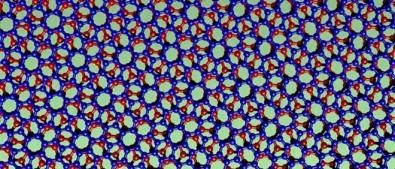Artificial magnetic field produces exotic behavior in graphene sheets
A simple sheet of graphene has noteworthy properties due to a quantum phenomenon in its electron structure named Dirac cones in honor of British theoretical physicist Paul Dirac (1902-1984), who was awarded the Nobel Prize for Physics in 1933.

Theoretical physics discovery paves the way for future technological applications. Study led by young Brazilian researcher featured on cover of Physical Review Letters
Jose Lado
The system becomes even more interesting if it comprises two superimposed graphene sheets, and one is very slightly turned in its own plane so that the holes in the two carbon lattices no longer completely coincide.
For specific angles of twist, the bilayer graphene system displays exotic properties such as superconductivity (zero resistance to electrical current flow).
A new study conducted by Brazilian physicist Aline Ramires with Jose Lado, a Spanish-born researcher at the Swiss Federal Institute of Technology (ETH Zurich), shows that the application of an electrical field to such a system produces an effect identical to that of an extremely intense magnetic field applied to two aligned graphene sheets.
Ramires is a researcher at São Paulo State University's Institute of Theoretical Physics (IFT-UNESP) and the South American Institute for Fundamental Research (ICTP-SAIFR). She is supported by São Paulo Research Foundation - FAPESP through a Young Investigator grant.
"I performed the analysis, and it was computationally verified by Lado," Ramires told. "It enables graphene's electronic properties to be controlled by means of electrical fields, generating artificial but effective magnetic fields with far greater magnitudes than those of the real magnetic fields that can be applied."
The two graphene sheets must be close enough together for the electronic orbitals of one to interact with the electronic orbitals of the other, she explained.
This means a separation as close as approximately one angstrom (10-10 meter or 0.1 nanometer), which is the distance between two carbon atoms in graphene.
Another requirement is a small angle of twist for each sheet compared to the other - less than one degree (α<<1°).
Although entirely theoretical (analytical and numerical), the study has clear technological potential, as it shows that a versatile material such as graphene can be manipulated in hitherto unexplored regimes.
"The artificial magnetic fields proposed previously were based on the application of forces to deform the material. Our proposal enables the generation of these fields to be controlled with much greater precision. This could have practical applications," Ramires said.
The exotic states of matter induced by artificial magnetic fields are associated with the appearance of "pseudo-Landau levels" in graphene sheets.
Landau levels - named after the Soviet physicist and mathematician Lev Landau (1908-1968), Nobel Laureate in Physics in 1962 - are a quantum phenomenon whereby in the presence of a magnetic field, electrically charged particles can only occupy orbits with discrete energy values. The number of electrons in each Landau level is directly proportional to the magnitude of the applied magnetic field.
"These states are well-located in space; when particles interact at these levels, the interactions are much more intense than usual. The formation of pseudo-Landau levels explains why artificial magnetic fields make exotic properties such as superconductivity or spin liquids appear in the material," Ramires said.
Original publication
Other news from the department science

Get the chemical industry in your inbox
By submitting this form you agree that LUMITOS AG will send you the newsletter(s) selected above by email. Your data will not be passed on to third parties. Your data will be stored and processed in accordance with our data protection regulations. LUMITOS may contact you by email for the purpose of advertising or market and opinion surveys. You can revoke your consent at any time without giving reasons to LUMITOS AG, Ernst-Augustin-Str. 2, 12489 Berlin, Germany or by e-mail at revoke@lumitos.com with effect for the future. In addition, each email contains a link to unsubscribe from the corresponding newsletter.





























































